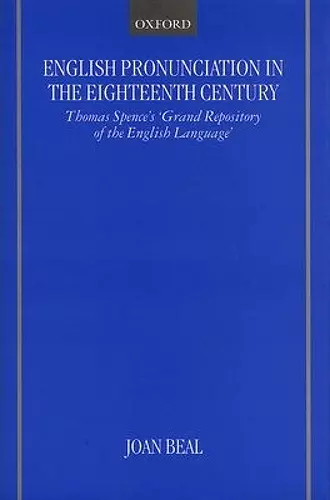English Pronunciation in the Eighteenth Century
Thomas Spence's 'Grand Repository of the English Language'
Format:Hardback
Publisher:Oxford University Press
Published:29th Apr '99
Currently unavailable, and unfortunately no date known when it will be back

Thomas Spence (1750-1814) was a native of Newcastle upon Tyne who is best known for his political writings, and more particularly for his radical `Plan' for social reform involving common ownership of the land. One hitherto neglected aspect of Spence's Plan was his proposal to extend the benefits of reading and of `correct' pronunciation to the lower classes by means of a phonetic script of his own devising, first set out and used in Spence's Grand Repository of the English Language (1775). The Grand Repository was one of many English pronouncing dictionaries produced in the late eighteenth century to satisfy the growing demands for a clear guide to `correct' pronunciation. It differs from its contemporaries firstly in that it was intended primarily for the lower classes, and secondly in that it is the only eighteenth-century pronouncing dictionary of English to use a truly `phonetic' script in the sense of one sound = one symbol. In this fascinating and unique account, Beal pays particular attention to the actual pronunciations advocated by Spence and his contemporaries with a view to reconstructing what was felt to be `correct' pronunciation in eighteenth-century Britain. With broad appeal to linguists and historians alike, this study highlights the importance of pronouncing dictionaries as a resource for the historical phonologist, and provides a valuable addition to the limited body of knowledge on eighteenth-century pronunciation.
Beal's study of a largely ignored eighteenth-century pronouncing dictionary is an important contribution to the field of English historical phonology largely through the benefits of its inclusive methodology: the technique leaves no relevant evidential stone unturned and the results are consequently firmly fixed in their historical, social and linguistic framework. * Margaret J-M Sonmez, J. Linguistics 36 (2000). *
a work that contains a number of new insights into sound change at the phonetic level, and into the interrelationship between phonic details, their social conditioning and their phonological implications. / From the smaller world of Thomas Spence's life and works to the larger context of language studies then and now, this is a book that makes connections. * Margaret J-M Sonmez, J. Linguistics 36 (2000). *
careful piecing together of evidence from many sources. * Margaret J-M Sonmez, J. Linguistics 36 (2000). *
the whole of [this] final section is essential reading for any student of Early and Later Modern English pronunciation. * Margaret J-M Sonmez, J. Linguistics 36 (2000). *
a tantalising glimpse of what can happen when evidence relating to phonetic and lexical diffusion is combined. * Margaret J-M Sonmez, J. Linguistics 36 (2000). *
Beal's work has a far wider significance than its subtitle might suggest, and the book is an important work of scholarship in eighteenth-century English phonology and in the history of English phonology more generally. * Margaret J-M Sonmez, J. Linguistics 36 (2000). *
Beal has done us a great favour in drawing Spence's work to our attention, and another in regulating and evaluating its content. * Alison Wray, Journal of Sociolinguistics *
this book may be seen as a valuable addition to a rather underesearched period of the English Language * Alison Wray, Journal of Sociolinguistics *
ISBN: 9780198237815
Dimensions: 241mm x 162mm x 19mm
Weight: 501g
256 pages